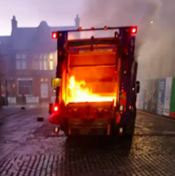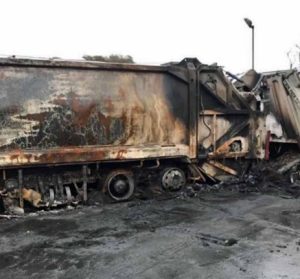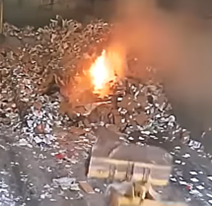Pushing the Facts!

As no doubt many of you will have seen, mainly because you can’t escape it, plastic is a hot topic.
Recently a report was released that claimed plastic Starbucks cold cups are not recycled. Thirty-six cups were electronically tagged to trace their end-of-life journey. The reports data showed that only 4 of these cups ended up at a materials recovery facility (MRF) for potential recycling, while the rest ended up either landfilled, incinerated, or just plain lost. Now, I’m not going to get drawn into whether I think a plastic Starbucks cold cup is recycled, because my issue isn’t so much with the ambition of the report, but with the execution of the research.
Small electronic tags have become the weapon of choice in the investigative reporter’s arsenal for tracking waste movements. There have been numerous accounts of people placing these tags inside products before binning them in the hope of tracing their final destination.
The majority of these tags are designed for tracking personal items. A bit like the ‘find my phone’ apps which can trace your mobile phone or smart watches, now tags can be added to virtually anything from laptops, bags and keys, to even shoes and pets if you really wanted to. Their batteries can last for up to a year and they are concealable or can be attached like a keyring.
At RECOUP, we spend a great deal of time at various MRFs for our members testing their packaging and working out if it ends up in the right material fractions to have the best chance at being recycled. I say best chance, because despite all efforts to get something into a material fraction, it doesn’t always mean it is going to be recycled once it gets there.
One thing we always tell our members, is that we need the packaging in the same condition it would be after consumers have thrown it away, this means it needs to have been filled with product and emptied. There is a good reason for this practice, and that is because the contents of a pack often leave residues, which if not rinsed can alter the weight balance of the pack. When the packaging is being sorted, if it is heavier at one end, it means that the pack has a strong chance of either the air jets not being strong enough to capture it, or just being spun off in a random direction, most likely to residual waste.
The Starbucks cup experiment relied on gluing tags between two plastic cold cups (let’s ignore the fact batteries cause fires for a moment) and placed them into bins at selected Starbucks and tracked them. Whilst their intentions were admirable, their execution was flawed.
You see, any respectable MRF, should one of these cups not arrive there in a burning refuse collection vehicle, is likely to spot the cups containing some kind of foreign object and remove it straight to residue. If that doesn’t happen, it is then likely to be missed by the optical sorting because it is heavier and drops into residues, or it might get captured by the eddy currents (the part that sorts aluminium), where it is also likely to be picked off manually and, you guessed it, directed to residue.
So with that in mind, are we surprised that from this test conducted only 4 cups appeared at MRFs? My only hope is that the 4 that appeared at MRFs didn’t do so because their systems missed them, and that they also got picked out and sent to an incinerator or a landfill.
Now I am always up for some objective debate about whether materials are actually recycled, but when we have news reports and ill-advised science experiments, it all gets a bit out of hand.
The report failed to consider the waste management and recycling systems in place and shows a clear lack of knowledge of the way materials are sorted for recycling. It should come as no surprise to anyone with any knowledge of the infrastructure that these tagged cups ended up in landfill or incinerators. If anything, the fact 4 made it to MRFs should be seen as a failure in the system to divert them as contamination from the recycling stream.
We are seeing an increase in reports that take flawed research and use it to make exaggerated and sensationalised claims about the recyclability of plastic being a lie. We as an industry need to make sure that we are calling out these reports with fact-based evidence and news agencies and other contributors to misinformation are held to account.
Now, coming back to the topic of fires. Barely a day can go by without someone, somewhere reporting on a fire at a recycling facility or in one of the refuse collection vehicles collecting from a street in the UK. Sometimes battery fires even start in the battery recycling collections at supermarkets.


Most of these fires, if not all can be attributed to lithium batteries. Single use disposable vapes are often blamed for recycling fires, but the fact is, anything that contains a lithium battery is a fire risk when placed into a recycling bin, even musical Christmas cards.

Once they are crushed or compacted the batteries can be punctured, which causes a chemical reaction within the battery leading to an explosive fire which ignites the surrounding material. Knowingly placing devices containing lithium cell batteries into recycling bins recklessly endangers the safety of not only the staff driving collection vehicles and at recycling facilities, but also the public who could have been impacted by a fire either on the road or at homes close to the recycling centres.
It is reported that fires cost the waste management industry over £100 million every year in downtime and repairs alone. Reporters need to consider their options before putting people’s lives at risk to produce a story that doesn’t even reflect the truth about the recycling industry. If they really want to find out where packaging goes, there are plenty of companies that would be willing to give them a site tour. They could even ask RECOUP if they can join one of our many member visits to find out more about the recycling process, it might not be as explosive, but it would certainly be safer.